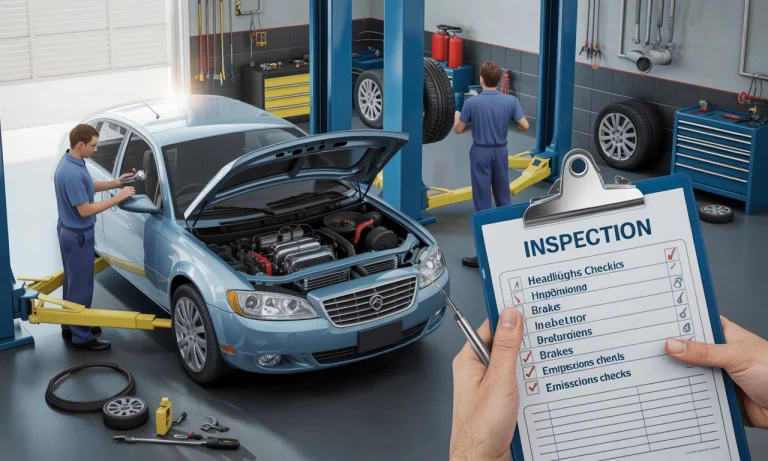Long before Sam pulled his car into the inspection bay, he could already feel the telltale nerves that grip even the most meticulous driver. Would that faint rattle raise concerns? Was the tread on his back tire still above legal limits? Across the country, thousands of drivers each day confront this moment—the stringency of a Vehicle Inspection standing between their car and another year on the road. In 2025, passing inspection is less about crossing off a bureaucratic hurdle and more about ensuring safety in a rapidly evolving automotive landscape. Modern Car Maintenance now meets high-tech diagnostics, as both seasoned mechanics and fresh AI tools scrutinize everything from Tire Pressure to Headlights Functionality. This narrative delves into the step-by-step journey of prepping any vehicle for that all-important inspection, blending real-life examples, checklists drawn from expert sources, and the latest digital tools all drivers have at their disposal. Whether it’s preparation for an annual check, a change in seasons, or a long-awaited road trip, the story of a car’s health always begins with a thorough inspection.
Understanding the Importance of Vehicle Inspection for Safety and Performance
When Sam inherited his father’s old sedan, local requirements demanded more than just basic paperwork. The Vehicle Inspection process became his initiation into automotive vigilance. Without regular checks, hidden issues fester—worn brake pads slumber beneath calm exteriors, low fluids quietly sabotage engines, and unnoticed cracks in windshield wipers threaten stormy-night visibility.
Inspections aren’t just about clearing legal thresholds—they are pivotal for road safety and financial wisdom. Small concerns like a lagging Brake System or faulty Headlights Functionality can snowball into major repairs, unexpected breakdowns, or worse—accidents. Sam learned quickly: reviewing the Safety Checklist and monitoring Fluid Levels with every oil change spared him anxiety when the inspection date loomed.
| Inspection Area | Checkpoints | Consequences if Ignored |
|---|---|---|
| Tires | Tread depth, pressure, damage | Poor grip, blowouts, failed inspection |
| Brakes | Pad thickness, fluid level | Reduced stopping power, safety risk |
| Lights | Headlights, indicators, brake lights | Visibility issues, failed safety check |
| Fluids | Oil, coolant, brake fluid | Engine damage, overheating |
The Financial and Legal Stakes in Passing a Car Inspection
Failing an inspection is more than an inconvenience; it impacts insurance premiums and can even put registration status at risk. Sam’s friend Jamie discovered this the hard way—her overlooked emissions check resulted in costly last-minute repairs and delayed work commutes. Essential resources like Car Maintenance for Peak Performance offer proactive strategies to keep surprises at bay, making each Emissions Check a manageable routine rather than an unpredictable ordeal.
Seven Steps to a Successful Vehicle Inspection
Sam’s mantra became “preparation eliminates surprises.” He adopted the seven-step Vehicle Inspection framework, each stage designed to gently unearth the subtle problems that can derail an otherwise smooth check.
| Step | Action | What to Look For |
|---|---|---|
| 1. Exterior Walkaround | Visual scan for dents/leaks | Unusual tilting, visible damage |
| 2. Under-the-Hood | Check oil, battery, belts | Oil level, cracked hoses, corrosion |
| 3. Interior Check | Ignition, warning lights | No strange sounds or alert icons |
| 4. Lights and Hazards | Test all lights | Bright, responsive, not flickering |
| 5. Tires and Mirrors | Inspect tires, mirrors | Tire pressure, damage, clear mirrors |
| 6. Signals and Brake Lights | Test turn/hazard signals, brakes | Proper flashing, responsive brake lights |
| 7. Brakes | Short test drive with braking | No squeals, smooth stopping |
Real-World Example: Sam’s Day at the Inspection Bay
Sam arrived, armed with recent receipts and digital records from this car maintenance guide. When the inspector eyed his service history, the thoroughness paid off—no anxious phone calls, and nothing flagged for a retest. Sam’s preparation highlighted one truth: correct Documentation reassures both driver and mechanic, especially in commercial settings where fleet compliance means dollars and downtime.
Focus Areas: Tires, Brakes, and Headlights in Inspection Protocol
No aspect of Car Maintenance reveals itself more dramatically than in tires, brakes, and lighting. Sam’s regular checks, inspired by stories from how to spot hidden issues in used cars, meant zero panic when technicians measured his Tire Pressure and tread in seconds. He knew a legal minimum was no guarantee of safety—rather, he aimed for optimal grip, correct spare inflation, and undamaged rims. Brake checks exposed more than pad thickness; fluid clarity and pedal responsiveness foretold the difference between a pass and a warning citation.
Why Lights and Visibility Systems Make the Difference
Loose battery terminals or a dying headlight bulb could sabotage the process, so Sam always tested lighting the night before inspection. Even Windshield Wipers were on his radar, after once learning—mid-thunderstorm—that streak-prone blades spelled a failed safety check. Navigating these details, he recognized: Headlights Functionality and operational signals form the thin line between a routine pass and a harried dash to the nearest auto store.
The Role of Fluids, Under-the-Hood Checks, and Emissions Control
Modern inspection procedures rarely skip under-the-hood checks. Sam made it a ritual, referencing tools from resources like test driving car tips to confirm Fluid Levels—engine oil, brake and transmission fluid—were clear and within marks. A single neglected line or darkened oil could be the harbinger of engine woes, while low coolant hinted at a looming overheating incident.
But 2025’s emphasis on clean air meant the Emissions Check stood as a defining moment. Technology like AI-powered assessments sped up the process, but the fundamentals remain: leaks, frayed hoses, and clogged filters compromise both efficiency and compliance. Timely attention, Sam realized, prevented both financial penalties and environmental harm.
Digital Record-Keeping and Inspection Efficiency
The game-changer in modern inspections is digital integration—scheduling checks, storing service records, and tracking repairs all from a smartphone. With new tools, fleet managers and solo drivers alike keep inspections transparent and efficient. No more missing Documentation or forgotten recall repairs to haunt an otherwise perfect record. The end result? Less stress, quicker checks, and a robust sense of security behind the wheel.
For those wanting more strategies, exploring guides like tips for buying a new car in 2025 can reveal how proactive maintenance and inspections increase the car’s value and lifespan while sidestepping avoidable headaches.
Commercial and Personal Vehicle Inspection: Stories from the Field
Fleet supervisors, unlike Sam, have dozens—sometimes hundreds—of vehicles to track. Automated, AI-powered platforms run comprehensive Safety Checklist reviews, plus commercial Emissions Check and undercarriage assessments. Accurate, real-time data has eliminated much of the manual drudgery, and photographic records document every scratch for compliance and resale.
For private owners, strides in technology mean peace of mind. Digital notifications ensure routine Car Maintenance is never forgotten, while cloud-based Documentation proves invaluable during roadside stops or insurance claims. The convergence of human vigilance and technological innovation underpins a safer, more confident driving experience for all.
Preparing for the Unexpected: Safety Features and Emergency Equipment
Sam’s meticulous checks paid off each time an emergency threatened his routine, whether it was a sudden flat tire or a brief power outage. He never underestimated the power of verified seatbelts, up-to-date airbags, and a stocked emergency kit—proof that a thorough inspection goes beyond the engine bay.
| Safety Feature | How to Check | Significance |
|---|---|---|
| Seat Belts | Retract, lock, visual check | Occupant safety |
| Airbags | No dashboard warning lights | Crash protection |
| Emergency Kit | Spare tire, jack, tools | Preparedness for breakdowns |
| Windshield Wipers | Clear screen, no streaks | Visibility in bad weather |
Frequently Asked Questions about Passing Car Inspections
How often should a safety inspection be performed?
A basic safety inspection is advisable every 3,000 to 5,000 miles, ideally synced with routine oil changes. Before long trips or season changes, a thorough check ensures all critical systems perform optimally.
What key tools help with an at-home inspection?
A tire pressure gauge, flashlight, fluid dipsticks, and a tread depth gauge cover most basics. For diagnosing dashboard lights, an OBD-II scanner proves useful. For complex checks, consult a mechanic equipped with professional tools.
What steps should be taken if a problem is detected?
Address issues such as low pressure or non-functional lights immediately. For deeper problems—like worn brake rotors—seek help from a qualified mechanic to avoid escalating risks and costs.
How do I confirm I’ve passed an inspection?
A passing inspection means every item on the Safety Checklist—from Fluid Levels to Headlights Functionality—has received the green light. Criteria may vary, so always check local regulations and requirements.
Can basic checks be managed at home?
Yes, most routine checks are manageable for diligent owners. Still, official inspections often uncover what’s invisible to amateurs, so an annual professional review is recommended for peace of mind and compliance.
Did you like it? 4.3/5 (26)







